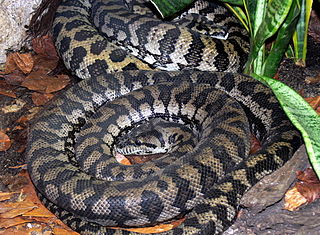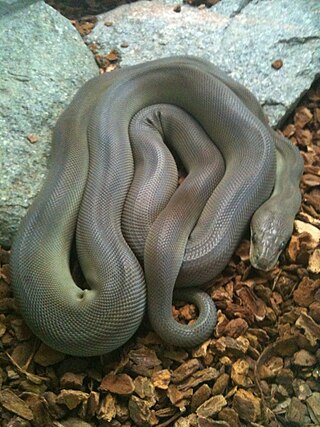Related Research Articles

The reticulated python is a python species native to South and Southeast Asia. It is the world's longest snake, and the third heaviest after the green anaconda and Burmese python. It is listed as least concern on the IUCN Red List because of its wide distribution. In several countries in its range, it is hunted for its skin, for use in traditional medicine, and for sale as pets. Due to this, reticulated pythons are one of the most economically important reptiles worldwide.

The green tree python is a species of snake in the family Pythonidae. The species is native to New Guinea, some islands in Indonesia, and the Cape York Peninsula in Australia. First described by Hermann Schlegel in 1872, it was known for many years as Chondropython viridis. As its common name suggests, it is a bright green snake that can reach a total length of 2 m (6.6 ft) and a weight of 1.6 kg (3.5 lb), with females slightly larger and heavier than males. Living generally in trees, the green tree python mainly hunts and eats small reptiles and mammals. It is a popular pet, and numbers in the wild have suffered with large-scale smuggling of wild-caught green tree pythons in Indonesia. Despite this, the green tree python is rated as least concern on the IUCN Red List of endangered species.

Children's python is a species of nonvenomous snake in the family Pythonidae. The species is named after John George Children. It is a nocturnal species occurring in the northern half of Australia and generally found on the ground, although it often climbs trees. Usually growing to about 1.0 m (3 ft) in length or more depending on the polymorphic variant, it is typically a reddish-brown colour, darker on the upper surface, and with many darker blotches, especially on younger specimens. The Stimson's python variant has much stronger and more variable colors; often being adorned with reddish-brown to chocolate blotches against lighter tan. It feeds mostly on small mammals and birds, and as with other pythons, it constricts its prey before swallowing it whole. It is a popular pet among reptile enthusiasts.

Simalia boeleni is a species of python, a nonvenomous snake in the family Pythonidae. The species is endemic to the mountains of New Guinea. No subspecies are recognized. Its common names include Boelen's python and the black python.

Python is a genus of constricting snakes in the Pythonidae family native to the tropics and subtropics of the Eastern Hemisphere.

The Oenpelli python or Oenpelli rock python is a species of large snake in the family Pythonidae. The species is endemic to the sandstone massif area of the western Arnhem Land region in the Northern Territory of Australia. There are no subspecies that are recognised as being valid. It has been called the rarest python in the world. Two notable characteristics of the species are the unusually large size of its eggs and its ability to change colour.

Simalia is a genus of snakes in the family Pythonidae.
The Pythonoidea, also known as pythonoid snakes, are a superfamily of snakes that contains pythons and other closely related python-like snakes. As of 2022, Pythonoidea contains 39 species, including the eponymous genus Python and 10 other genera of pythons, all in the family Pythonidae, as well as two lesser-known families, Loxocemidae and Xenopeltidae.

Morelia spilota spilota is a subspecies of carpet python, popularly known as the diamond python. It is a medium to large snake, found in coastal areas and adjacent ranges of south-eastern Australia. It is the most southerly occurring python in the world and is found at higher altitudes than any other species of Australian python.

Morelia spilota variegata, commonly known as Torresian carpet python, Darwin carpet python or northwestern carpet python, is a subspecies of python found in New Guinea and Australia, smaller than the nominate subspecies Morelia spilota spilota and has a more restricted geographic range.

The olive python is a species of snake in the family Pythonidae. The species is endemic to Australia. Two subspecies are recognized, including the nominate subspecies described here.

Morelia imbricata is a large snake found in southern regions of Western Australia and western South Australia. A member of the python family, it is commonly known as the southwestern carpet python.

Liasis mackloti, commonly known as Macklot's python or the freckled python, is a species of python, a non-venomous snake in the family Pythonidae. The species is endemic to Indonesia, East Timor, Papua New Guinea, and coastal northern Australia. Three subspecies are recognized, including the nominate subspecies described here.
This article lists the various snakes of Australia which live in a wide variety of habitats around the country. The amethystine python or scrub python is considered Australia's largest native snake.

Malayopython is a genus of constricting snakes in the family Pythonidae. The genus is native to India and Southeast Asia. It contains two species, both of which were previously classified within the genus Python. However, multiple studies recovered these species as distinct. Known as the "reticulatus clade", it was eventually found to be a sister lineage to a lineage giving rise to the Indo-Australian pythons rather than the genus Python.

The Australian scrub python, or simply scrub python is a species of snake in the family Pythonidae. The species is indigenous to forests of northern Australia. It is one of the world's longest and largest snakes, and is the longest and largest in Australia. Recently, it has been reclassified to the genus Simalia alongside a few other former Morelia species, but scientific debate over this continues.

Crocosaurus Cove is a crocodile herpetarium and aquarium zoo located in an indoor complex in the city district of Darwin, Northern Territory, Australia. Its main focus as the facility's name indicates is the tourism drawcard of the crocodiles of northern Australia. The park has a considerable number of saltwater crocodiles including 700kg and 5.1 metre long male Burt, who appeared in 1986 movie Crocodile Dundee and made news in 2018 for 'psychic predictions' outcomes of the 2018 Soccer World Cup by reaching up and grabbing photographs of players which was seen as match and player performance 'predicting'. The facility has also had success with breeding and hatching baby crocodiles including in July 2022 with baby crocodiles hatched to parent crocodiles female Kate and male William. One of the things most well known at the facility which significantly increased visitor numbers is a 'cage of death' experience where paying visitors can swim in water with large crocodiles while protected from physical contact with them by being enclosed behind a glass safety dome. As previously mentioned a significant number of other native Australian reptiles are also kept at the facility and publicly exhibited. Mick Burns the owner is also owner of Darwin Crocodile Farm.
References
- ↑ "Pythonidae". Integrated Taxonomic Information System . Retrieved 11 September 2007.
- ↑ McDiarmid, R.W.; Campbell, J.A.; Touré, T. 1999. Snake Species of the World: A Taxonomic and Geographic Reference Vol. 1. Herpetologists' League. 511 pp. ISBN 1-893777-00-6 (series). ISBN 1-893777-01-4 (volume).
- ↑ Harvey, M.B.; Barker, D.G.; Ammerman, L.K.; Chippindale, P.T. 2000. "Systematics of pythons of the Morelia amethistina complex (Serpentes: Boidae) with the description of three new species". Herpetological Monographs, 14: 139-185.
- ↑ Keogh, J.S.; Barker, D.G.; Shine, R. 2001. "Heavily exploited but poorly known: systematics and biogeography of commercially harvested pythons (Python curtus group)". Southeast Asian Biological Journal of the Linnean Society, 73:113-129.
- ↑ Schleip, W. 2008. "Revision of the genus Leiopython Hubrecht 1879 (Serpentes: Pythonidae) with the redescription of taxa recently described by Hoser (2000) and the description of new species". Journal of Herpetology, 42: 645–667.